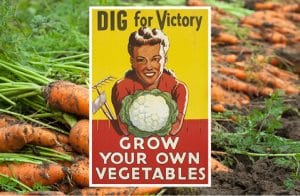 Victory Gardens Then and Now
Victory Gardens Then and Now
How to start
Think about what you like to eat and start with that. A basic vegetable garden will take up a medium-to-large amount of space, depending on what you plant. It’s possible to break it up if you don’t have one large area. Aim for an area that gets direct sunlight for 6 to 8 hours per day, less if growing tender greens.
Peas, cucumbers, and beans are climbers. You’ll need to build a trellis for them to grip on to, or attach a temporary lattice against a fence or wall. Consider building a teepee frame for them to climb up.
Tomatoes like a nice hot, sunny place — they can be happy planted into individual pots, and even a 15-gallon size container can do nicely. Don’t forget the tomato cage to keep them upright later in the season when they’re heavy with fruit.
Leafy greens prefer some shade from mid-day and late afternoon sun. Their roots are shallow, so try them planted into boxes or pots. Nothing too small that will dry out too quickly.
Pumpkin, squash, and melons need a lot of space to produce fruit. Set aside an entire garden space just for one of these crops or consider planting a “three sisters” garden with corn, green beans, and squash to save space.
Prepare the soil
- Dig up the soil to loosen, then mix in organic matter to add nutrients to the soil. A crumbly texture is best, not too fine. Sloat Loam Builder is an excellent amendment for water-soluble nutrients that are available quickly for fast-growing vegetables.
 Use Sure Start fertilizer in planting holes of new starts to develop strong roots.
Use Sure Start fertilizer in planting holes of new starts to develop strong roots.
Watering
- Keep seedlings consistently moist and monitor frequently to keep them from drying out.
- For small starts, water well two to three days per week to keep soil evenly moist.
- Protect from snails, slugs and sowbugs with Sluggo Plus
Fertilize
- Fertilize with a good slow-release fertilizer.
- Add some flowers. Flowers are not only beautiful to look at, but they also draw pollinators to the garden.
- Try: Alyssum, Coreopsis, Marigold, Lavender, Yarrow, Zinnia, Veronica, Scabiosa, Lobelia, Ajuga, Herbs


